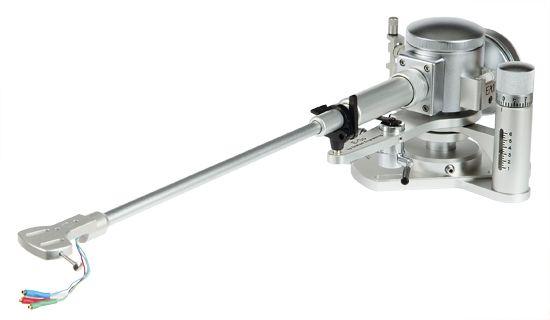Euro Audio Team E Go (£6300)

One of the world’s most expensive, highly-developed tonearms are ‘unipivots’, though in some cases they have additional bearings: Mørch has a dual pivot to give lateral stability, Kuzma a cunning four-point system; Continuum’s Cobra arm uses a secondary outrigger pivot mounted on its own bearing.
However, it was left to Bob Graham of Graham Engineering to come up with what is arguably the most elegant way of maximising the benefits of the unipivot concept and smoothing away its disadvantages. The breakthrough came with his ‘Magneglide’ magnetic stabiliser system – the major innovation of the first, B-44, Phantom arm.
Graham lists six separate benefits for it: increased lateral stability, easy azimuth adjustment, a higher lateral inertia component for improved bass reproduction, augmentation of system damping, true vertical pivoting of the stylus with no rotation as the arm is raised, and easily adjusted anti-skate compensation.
The really clever part of this system is its azimuth tower, mounted on a swivelling collar which allows it to rotate about the arm pillar. A cylindrical projection on the right side of the arm bearing housing contains a neodymium magnet centred at the same height as the arm pivot. This attracts a second similar magnet attached to the azimuth adjustment tower, which in turn is connected to the fixed arm base. The azimuth tower follows the lateral movement of the arm as it tracks across the record, keeping the arm exactly in position and preventing it from wobbling.
With the current Phantom II Supreme the stabiliser has been improved, there is new internal wiring and a new titanium arm wand, available in three lengths. EAT’s version of the Phantom II Supreme, the E-Go, comes only as a 12in, resplendent in matt chrome.
In essence, the Graham bearing is a simple damped point and cup arrangement, both precision-made in Switzerland from tungsten carbide. On first installation, you fill the cup with an appropriate quantity of damping oil, then replace the top cap.
Azimuth adjustment is carried out by raising or lowering the magnet via a screwthread on its swivelling tower, this causing the arm to tilt as required. While you must not adjust azimuth during play, you can adjust the arm height and hence VTA.
Resolving a paradox
As the E-Go has a short back, it fitted our SME 30/12 without hitting the rear right pillar. The E-Go is one of the most user-friendly unipivots to set up; its removable wand makes it easy to change cartridges too – we settled on Air Tight’s PC1.
We put on Gram Parsons’ Grievous Angel [Reprise] and what made us sit up and take notice was the drum-roll at the end of the track ‘I Can’t Dance’. It wasn’t mere impact: for that we’d turn to Kodo. It was about space and a lack of artifice. The sound of what is just a standard LP possessed the air and three-dimensionality of the crafted-to-a-millimetre sound of the notorious Sheffield Drum Record. We rubbed our eyes in disbelief.
It was followed by the delicate piano opening of ‘Brass Buttons’, compounded by pedal steel and crisp, but discreet percussion … there was nothing ‘brassy’ about it at all. It managed, despite a surfeit of terse transients, to sound silky.
The duet on ‘Love Hurts’ with Parsons’ muse, Emmylou Harris, is so achingly gorgeous that you begin to appreciate a system’s abilities with vocal textures and spacing. The two stand extreme left and right, the instruments filling in the space – reflecting the song’s title by using separation to convey the angst of love. The E-Go perfectly resolved what is one of the most challenging of paradoxes: reproducing bags of information while creating what appears as a sparse soundscape.
Verdict
EAT’s version of the Graham tonearm is as genuinely a ‘high-end’ purchase as one could make, bristling with clever details and sounding gorgeous. Best of all, it’s a unipivot free of masochism.
Originally published in the 2013 yearbook
























































